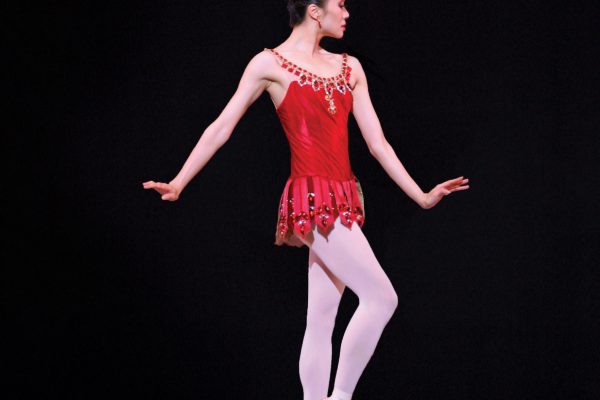Cacti is a delightfully silly and playful ballet, but also a sharply satirical and pulsating presentation. Its immersive effect is accentuated by its strategic place in The National Ballet of Canada’s recent mixed programme, which also features Balanchine’s The Four Temperaments and Rubies.
Created by Swedish choreographer Alexander Ekman, Cacti premiered in Oslo six years ago and made a resounding impact as it entered The National’s repertoire Wednesday evening.
At its heart, Cacti offers commentary on the state of ballet, and the state of art at large, through pretentious and tongue-in-cheek staging effects. Beginning with a pompous monologue that touches on indigenous culture and technology, among other subjects, the thirty-minute work demands the audience abandon its obsession with linear narrative and instead embrace a more referential relationship between physical, non-representational movement and production elements. It makes a statement about visceral response while evoking just that.
The strengths of Cacti lie in the risks it takes. Despite what transpires on stage and is expressed through ostentatious voiceover segments by Spenser Theberge, the highly self-aware ballet relies on non-traditional means to guide the audience and spur its intended reaction.
The elements that enforce Cacti’s criticism of contemporary dance are spectacular. The production showcases complex and compelling movements by sixteen highly skilled dancers who appear at the opening like creatures of the mist rising at various intervals to a new day’s light. Displaying commendable acting capabilities, they spend much of their time atop square platforms, where they beat their chests, pound their podiums, clap their hands and even vocalize. Later, they reposition their platforms to erect an abstract formation with which they inventively interact.
Wearing nude-coloured unitards, the dancers demonstrate impressive stamina and their level of collaboration breeds beautiful unison. Ekman’s innovative choreography creatively utilizes space and the dancers convey this with precision.
The superb dancing is complemented by a score featuring Haydn, Beethoven, Schubert, Andy Stein and Mahler. A string quartet snakes around the stage playing portions of it, while the orchestra in the pit completes the captivating soundscape.
Not to be outshone, Thomas Visser’s lighting is masterful. It adds a dynamic factor to the production, with fixtures blinking to musical rhythm and rising and descending to provide another layer of depth.
Ludicrous at moments while ironic at others, Cacti employs the succulent plants after which it is named. The dancers maneuver cacti of several shapes and sizes throughout the latter half of the production, raising them as if in an offering to the gods and then situating them around their platforms. Their purpose, however, is rooted in Ekman’s underlying theme: to juxtapose, rather than explain.
To experience the eccentricities of Cacti, audience members first face George Balanchine’s productions The Four Temperaments and Rubies.
The former is one of Balanchine’s most frequently performed ballets, having premiered in New York City nearly seventy years ago. It illustrates the choreographer’s characteristically pared-down style, with minimal costumes and near nonexistent set décor. The exquisite movement of the dancers takes centre stage.
The Four Temperaments is Balanchine’s nod to the medieval concept of the four humours: melancholic, sanguinic, phlegmatic and choleric. A neoclassical production set against Paul Hindemith’s impassioned score, it exhibits rigid dance. With flexed feet and movements that implode rather than spill outward, the style sparked a shift toward an alternative dance that moved away from what was commonly considered pretty. The powerful, angular motions of the sanguinic variation, seductively danced by Svetlana Lunkina and Naoya Ebe, most distinctly exemplify this.
Rubies is Balanchine’s tribute to America. In 1967, his three-act ballet Jewels made its debut, comprising Emeralds, Rubies and Diamonds. Since then, the light, joyous centrepiece of the ballet has most satisfied audiences.
Aiming to convey America’s cultural contributions, Rubies gleams with spirit. As the production heats up, the dancers’ sparkly red costumes by Karinska create a fascinating illusion of flickering flames flitting across the stage. Capturing the jazzy sound of the 1930s, guest pianist Pamela Reimer bolsters Igor Stravinsky’s stimulating “Capriccio for Piano and Orchestra”. The brilliant music keeps the talented dancers darting like lightning.
Balanchine’s choreography in Rubies involves high extensions and jutting hips, both of which the dancers hit with conviction and intensity. Real-life couple Guillaume Côté and Heather Ogden embody this enthusiasm, but not as ardently as the “Tall Woman”, portrayed by Xiao Nan Yu, who is most luminous among a cast of radiant gems.
The concoction of Balanchine’s ballets and Ekman’s quirky Cacti is equal parts engaging and thought-provoking, one fans of dance may very well desire again.
The mixed programme runs from March 9 through 13 at the Four Seasons Centre for the Performing Arts in Toronto.
Tagged: Ballet, Cacti, Emerging Arts Critics Programme, Performance, Rubies, The Four Temperaments, ON , Toronto





